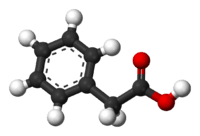Phenylacetic acid
| Phenylacetic acid | |
|---|---|
 | |
 | |
| IUPAC name Phenylacetic acid | |
| Identifiers | |
| CAS number | 103-82-2 |
| ChemSpider | 10181341 |
| UNII | ER5I1W795A |
| ChEBI | CHEBI:30745 |
| ChEMBL | CHEMBL1044 |
| Jmol-3D images | Image 1 |
| |
| |
| Properties | |
| Molecular formula | C8H8O2 |
| Molar mass | 136.15 g/mol |
| Density | 1.0809 g/cm3 |
| Melting point | 76–77 °C |
| Boiling point | 265.5 °C |
| Solubility in water | 15 g/L |
| Acidity (pKa) | 4.31[1] |
| Hazards | |
| MSDS | External MSDS |
| Except where noted otherwise, data are given for materials in their standard state (at 25 °C (77 °F), 100 kPa) | |
| Infobox references | |
Phenylacetic acid (abr. PAA and synonyms are: α-toluic acid, benzeneacetic acid, alpha tolylic acid, 2-phenylacetic acid) is an organic compound containing a phenyl functional group and a carboxylic acid functional group. It is a white solid with a disagreeable odor. Because it is used in the illicit production of phenylacetone (used in the manufacture of meth/amphetamine), it is subject to controls in the United States.
Occurrence
Phenylacetic acid has been found to be an active auxin (a type of plant hormone),[2] found predominantly in fruits. However, its effect is much weaker than the effect of the basic auxin molecule indole-3-acetic acid. It is also the oxidation product of phenethylamine when acted on by the enzyme monoamine oxidase found in humans and many other organisms.
Preparation
This compound may be prepared by the hydrolysis of benzyl cyanide:[3][4]

Applications
Phenylacetic acid is used in some perfumes, possessing a honey-like odor in low concentrations, and is also used in penicillin G production. It is also employed to treat type II hyperammonemia to help reduce the amounts of ammonia in a patient's bloodstream by forming phenylacetyl-CoA, which then reacts with nitrogen-rich glutamine to form phenylacetylglutamine. This compound is then secreted by the patient's body.
See also
References
- ↑ Dippy, J. F. J.; Hughes, S. R. C.; Rozanski, A. (1959). "The dissociation constants of some symmetrically disubstituted succinic acids". Journal of the Chemical Society 1959: 2492–2498. doi:10.1039/JR9590002492.
- ↑ Wightman, F.; Lighty, D. L. (1982). "Identification of phenylacetic acid as a natural auxin in the shoots of higher plants". Physiologia Plantarum 55 (1): 17–24. doi:10.1111/j.1399-3054.1982.tb00278.x.
- ↑ Adams R.; Thal, A. F. (1922), "Phenylacetic acid", Org. Synth. 2: 59; Coll. Vol. 1: 436
- ↑ Wenner, W. (1952), "Phenylacetamide", Org. Synth. 32: 92; Coll. Vol. 4: 760
